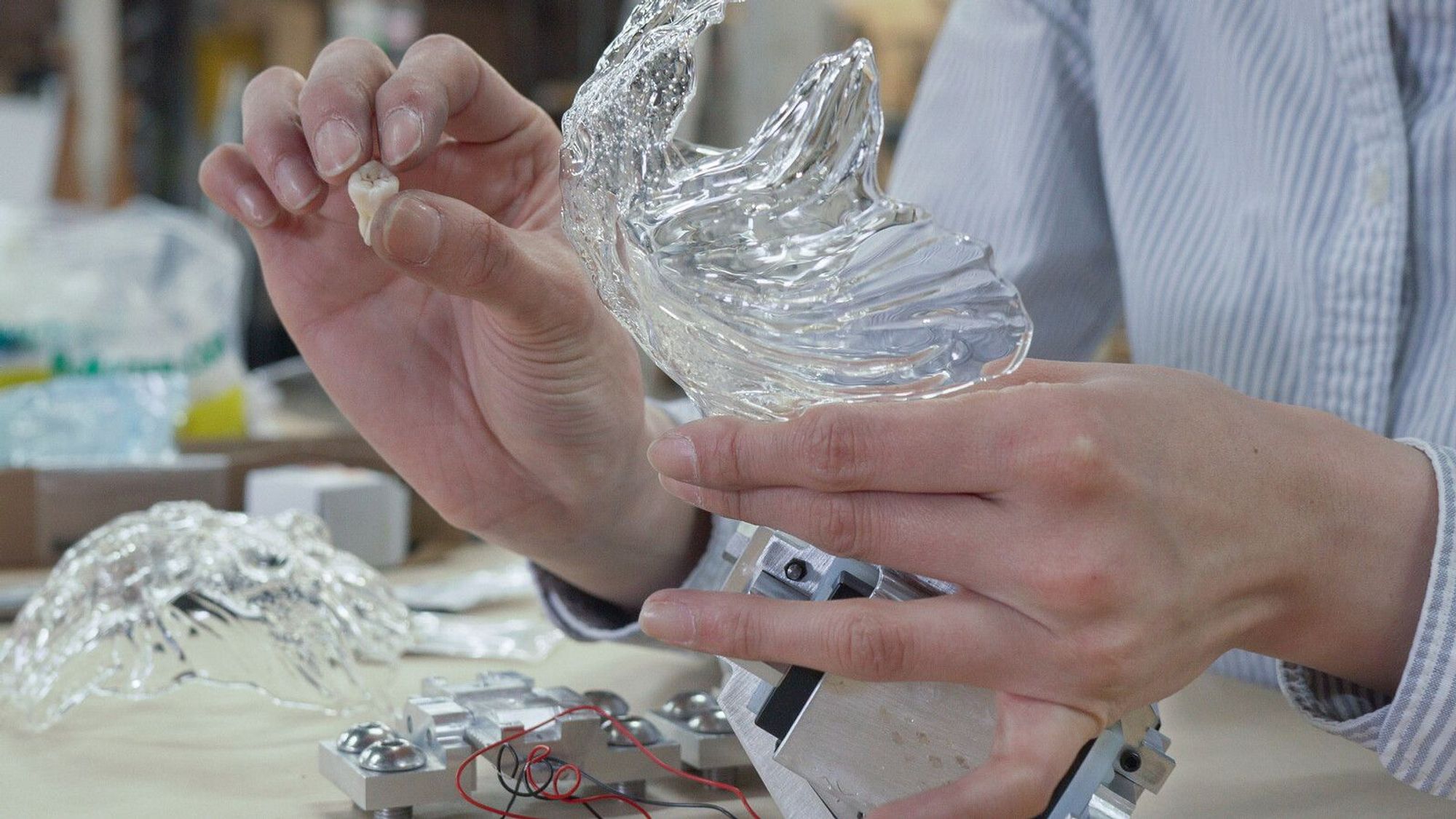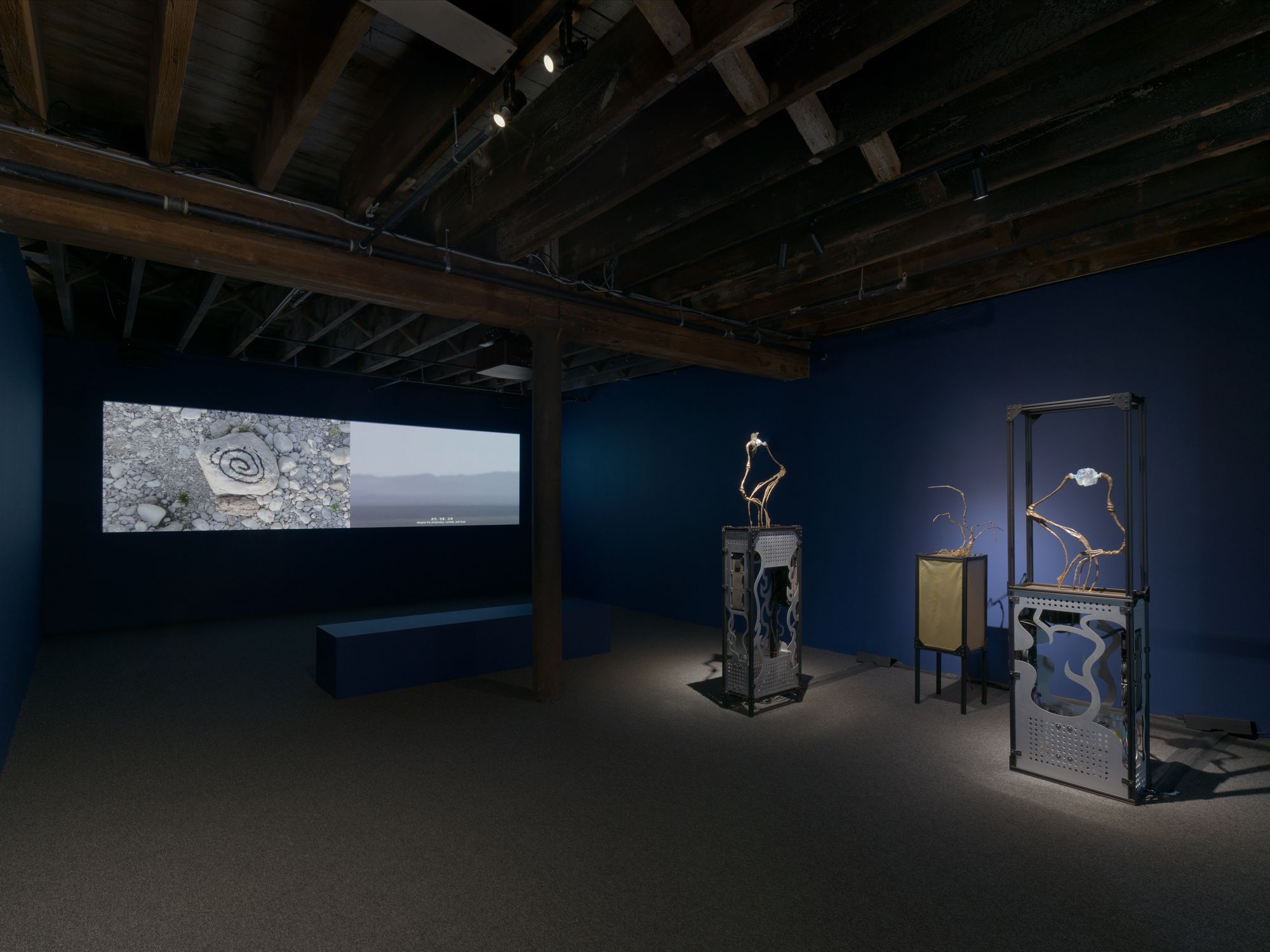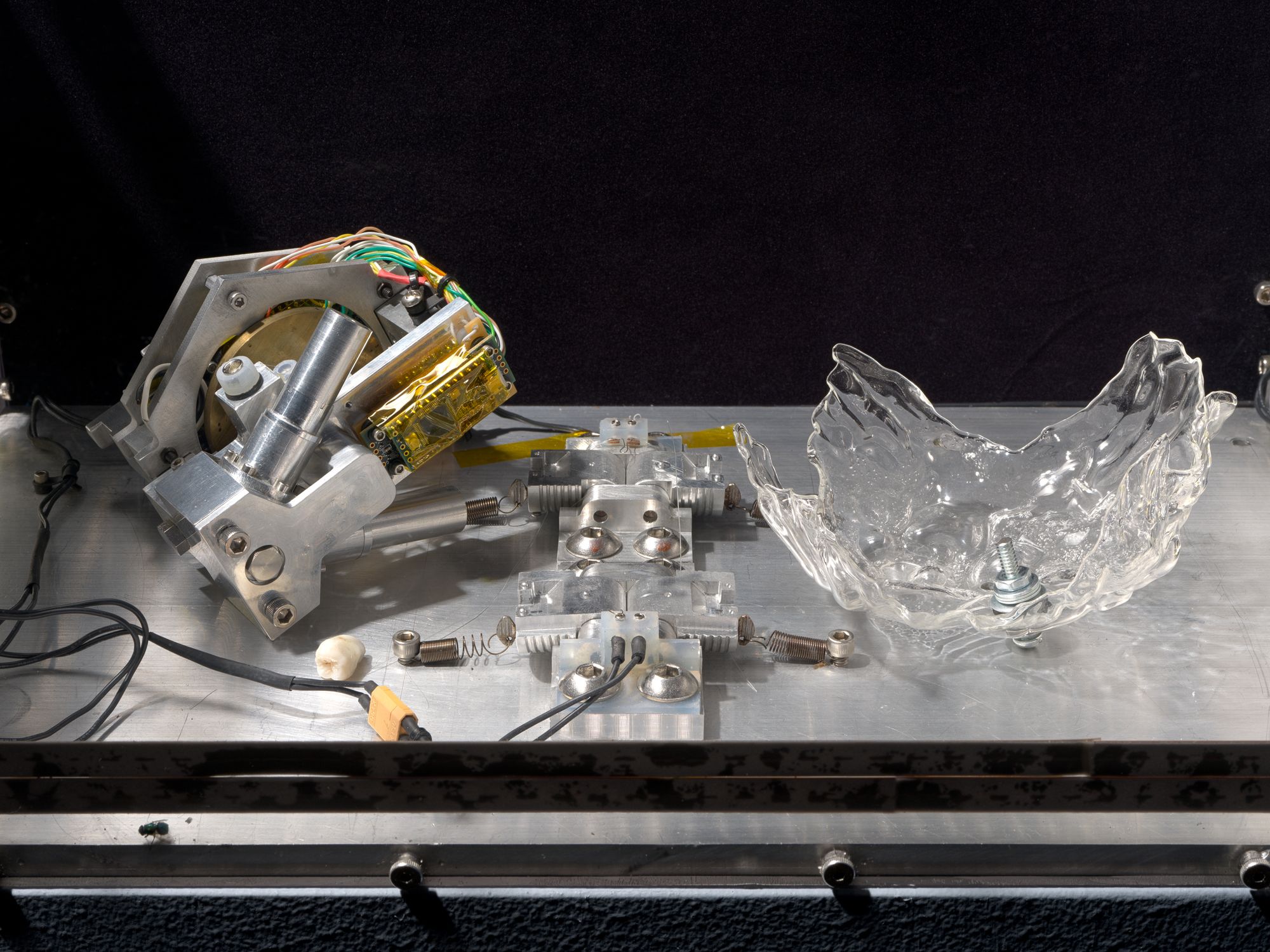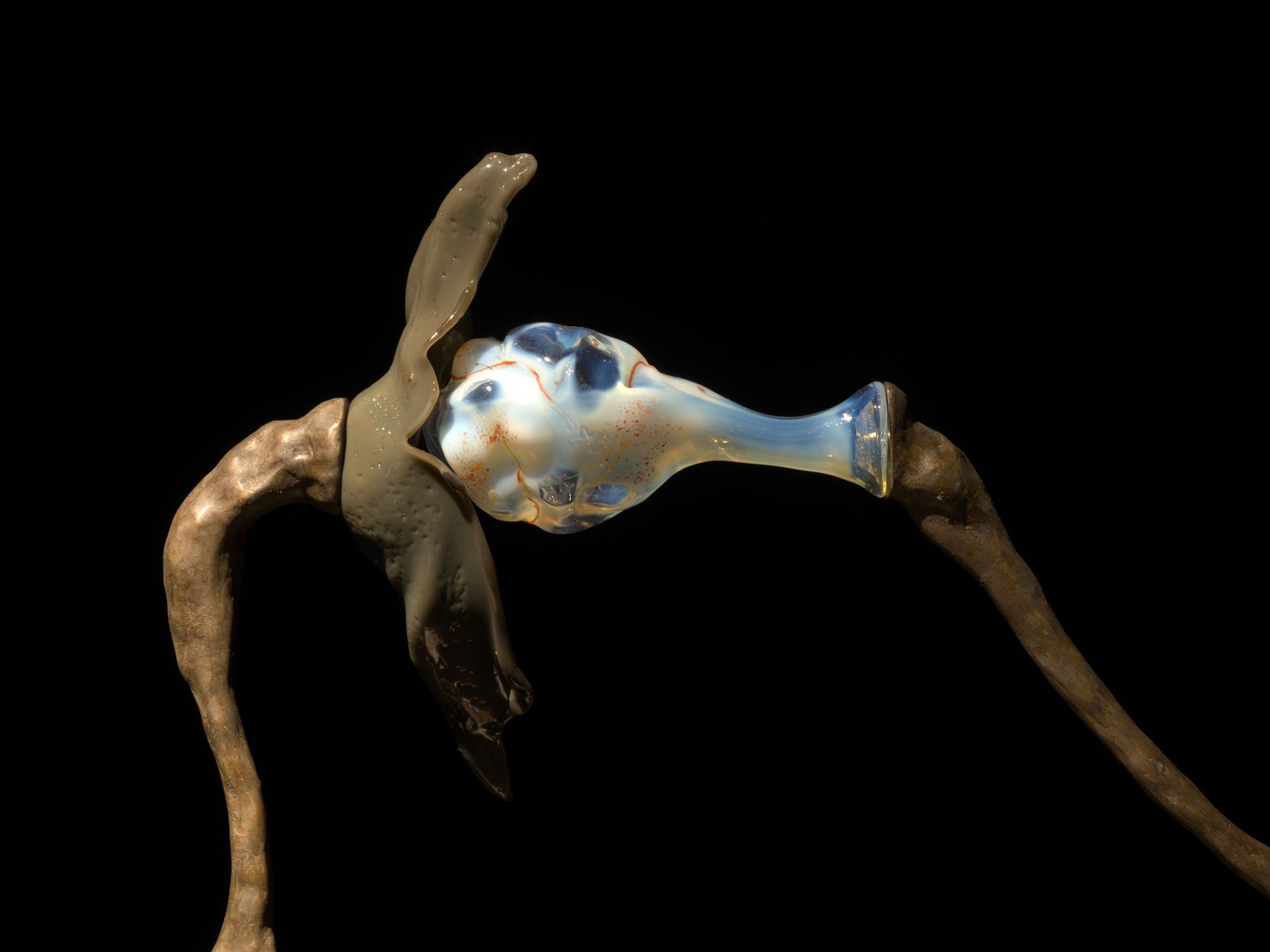Gravity is the Momentum of Feelings
Xin Liu, Orbit Weaver, 2017. Production still of artist's performance during a parabolic flight. Image courtesy of Steve Boxall, ZeroG.
On a planet where no light shines / Not to be swallowed up by the darkness / I watched the evening glow / Ten thousand years ahead, alone. —“Starduster,” written by JimmyThumb-P for Vocaloid idol Hatsune Miku
Xin Liu describes her first experience with weightlessness—on a parabolic flight that simulates zero gravity—as a shocking, “body-opening” experience. “There was no ‘freedom from gravity,’” she mused: “Gravity is always there. It was just everything falling For Liu, the paradoxical sensation of both floating upwards and falling encapsulates the Icarus-like allure of astronomical excursions: the quest, the ascent, the return. This parabolic flight, which was launched and supported by the Space Exploration Initiative at the MIT Media Lab, also set the stage for Liu’s performance work Orbit Weaver (2017). Inspired by the three-dimensional mobility of spiders, Liu designed a hand-held device that allowed her to navigate the zero-gravity environment by shooting a string; a magnet at the tip adhered to the surrounding surfaces, dragging the “wearer” around in space.

Xin Liu, Living Distance, 2019-20. Production still of artist adding the tooth to the device.
Photo: Steve BoxellWorking primarily as a “space artist,” Liu plays with the political and poetic implications of cosmos-oriented ambitions with the fastidiousness of a well-trained scientist. Born and raised in the post-industrial Karamay oil fields in Xinjiang, Liu’s upbringing has always evoked in her mind the terrains of Mars and extraterrestrial life. Liu studied engineering in precision instruments at Tsinghua, one of China’s most prestigious universities, before pivoting to fine art at the Rhode Island School of Design and the MIT Media Lab, in a program renowned for its dynamic mixture of art and technology. She recalls that her decision to become an artist was informed by the rationale—or rather, urge—to become a “complete human being,” despite her instinct, as “a pragmatic immigrant,” to pursue more conventional tech jobs. In her recent exhibition at Pioneer Works, Seedlings and Offsprings, Liu used methods and themes of space travel to forge a connection between migration and space exploration, offering a vital new resonance for the larger “space art” discourse.
Liu's immigration story has always felt evocative, for her, of both death and space travel. Leaving China felt like death because a new path was forged; choosing to live, work, and love in a very different cultural context necessarily terminated other possibilities. This loss of lives unlived only began to register later in adult life, when grief became the melancholic undertone of ambition. And as for space travel, it felt like a fitting metaphor for transporting into a different world, switching identities. There’s a Japanese vernacular term that has been widely adopted by Chinese youth to describe the grandiose delusions characteristic of one’s early teenage years. Chūnibyō, or “second-year syndrome,” is defined by the romantic pursuit of the unknown and a sense of naïve bravado. Liu expressed this sentiment in her work Living Distance (2020), in which she launched her wisdom tooth into space— a dramatic reenactment of a Chinese ritual where parents toss their children’s bottom baby teeth to the roof of their homes, or bury upper teeth underground, to augur healthy growth. For Living Distance, Liu created a small robot named EBIFA (Everything Beautiful Is Far Away) to carry her tooth to space in May of 2019, aboard a rocket named New Shepard, operated by Jeff Bezos’s space company Blue Origin. The work’s VR version, installed in the Pioneer Works exhibition, allowed visitors to embody the wisdom tooth as it floated, crashed, and disintegrated within the frames of EBIFA throughout the journey.
The artist considers this wisdom tooth to be the first part of her body to have entered space. It brings to mind the thrilling plot twist in Liu Cixin’s Three Body Problem sci-fi trilogy, when humans on earth, faced with weight limitations on a spacecraft, decide to send a single brain to space to infiltrate galactic enemies. Another important reference for Living Distance—and Liu’s early practice in general—is the sci-fi anime Neon Genesis Evangelion, which profoundly shaped her teen psyche. “The story is simple,” Liu explained in a 2021 interview: “An autistic child ponders whether people should attempt to understand one another, or live together with differences. You might find that childish, but these are issues we attempt to resolve all our lives. The significance of this anime is that it grounds such topics in the lived experiences of a middle schooler, which gave me courage: that is to say, you can tackle bigger topics. The way it combined the spiritual, the mechanical, and the cosmic deeply resonated with my

Installation view of Xin Liu: Seedlings and Offsprings at Pioneer Works, July 7 - September 10, 2023. Courtesy of the artist and Pioneer Works.
Photo: Dan Bradica
Installation view of Xin Liu: Seedlings and Offsprings at Pioneer Works, July 7 - September 10, 2023. Courtesy of the artist and Pioneer Works.
Photo: Dan Bradica
Installation view of Xin Liu: Seedlings and Offsprings at Pioneer Works, July 7 - September 10, 2023. Courtesy of the artist and Pioneer Works.
Photo: Dan BradicaThe beauty of the second year “syndrome” is that one approaches issues unfathomably bigger than oneself with a brazen sense of ownership and curiosity, a kind of naïve optimism that mobilized people like Liu and me to move across the globe (from China to the US) at a young age, on our own. Liu’s space oriented practice finds its origins in the Land Art movement of the 1970s, which sought to establish art’s relevancy to cosmic contexts, and iconic images such as Blue Marble (1972), a photograph of Earth taken by the crew of the Apollo 17 spacecraft on its way to the moon. Shot during the Cold War-era space race between the US and the USSR, the image provided striking visual evidence of the earth’s suspension in an infinite expanse. Blue Marble poetically looms in the artist’s work The Earth Is an Image, a browser-based piece commissioned in 2021 by Hong Kong’s M+ Museum. The work’s web-based portal allows visitors to tap into real-time orbital footage of Hong Kong from retired satellites, in the form of grainy sounds and aerial images. For The White Stone (2021), another romantic quest that encompasses both video and sculptural installation, Liu chased both the event of witnessing fallen rocket bits after launching as well as the material evidence of rocket debris in southwestern China (tracing back to the 1990s). Crucially, the sculptural works incorporated these fallen objects—which are considered restricted national properties—into their form and
In both works, time is a crucial dimension—how one can manipulate it remains a central inquiry for astronomists and space artists alike. As she entered her thirties, Liu discovered that her “second-year syndrome” gave way to a poignant and sometimes agitated awareness of the social, ethical, and emotional registers of motherhood. She’s since turned her attention to reproductive rights as well as reproductive technology, considering the overlap between cryonic research and long-haul space travel. For her recent exhibition at Pioneer Works, Liu created a series of mixed-media sculptures inspired by technologies such as cryonics and egg freezing, which are designed to interfere with natural life cycles. These alien-looking, erotically evocative sculptures are embedded with a cooling mechanism that causes thin layers of frost to appear across their surfaces. The artist pondered on the technology that extends our reproductive window: “I am fearful of this implication of time being only worth passing while it’s useful, while we are producing.” Liu’s mother, a gynecologist, never shied away from sharing the horrors and unvarnished realities of childbirth. But only in recent years have Chinese women publicly broached the topic of “feces, urine, and gas of birthing,” as well as other forms of labor and traumas of motherhood, on social media. None of these issues should be strange for the scope of space art, however—after all, it is an extreme and expanded form of public art.
On Liu’s website, a sentence below her name reads, “Gravity is a momentum of feelings.” This line can be interpreted as a concise artist statement. The art world still seems skeptical—at times hostile—toward rigorous scientific thinking, yet both the humanities and sciences seek to probe our ontological and existential condition. And nothing coheres the two as incandescently as space art. Liu’s work might be about space on the surface, but it also contains a parallel story about immigration and displacement, for diasporic art practitioners like us; as products of population-management such as the One Child Policy and post-socialist childhoods in industrial monotowns, we’re now literal “aliens” (the technical term for foreign nationals in the US) whose existence can feel at once onerous and liberating. A few years ago, during the pandemic, the artist told me that her favorite piece of space art is The Man Who Flew into Space from His Apartment (1985) by the Soviet-born Ukranian-American artist Ilya Kabakov. The installation presents a crammed yet unoccupied room with the roof blown open. The title implies that we are witnessing the immediate aftermath of a carefully-plotted take-off. “Though both are heading towards outer space,” she reflected, comparing her own impulses to the event engineered by Kabakov, “the Soviet campaign in space exploration and a personal desire to leave, to be free, cannot be more different. In fact, one is defeating the other.” In May of this year, Kabakov departed from the earthly realm. We are fortunate to still have Liu to guide us to the stars.♦
Subscribe to Broadcast